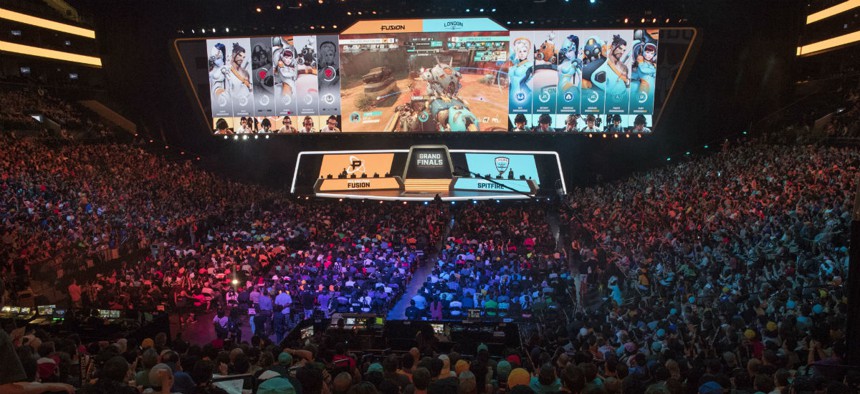How to Design an Esports Arena

Fans watch the last July’s competition between Philadelphia Fusion and London Spitfire during the Overwatch League Grand Finals competition in New York. Mary Altaffe/AP
An architect working on Philadelphia’s future esports arena explains the basics of designing for video-game competitions.
A $50 million esports arena, the first of its kind in the country, is coming to Philadelphia. The 65,000-square-foot Fusion Arena will host home games for the Philadelphia Fusion, the professional nine-person team in the 20-team Overwatch League.
Construction on the site in South Philly— a stone’s throw from where the Flyers, Phillies, and Eagles play—will start this summer, with an expected 2021 opening date. Fusion Arena will mainly be home to the Fusion’s year-round recruitment, training, and competitions, but the arena will also host occasional outside events.
Some might see this as an unnecessary shrine to a niche subculture. But for fans of esports (or professional video-game competitions), this was an inevitable next step. An estimated 250 million people watch esports, although most do so from the comfort of their homes. Global revenue is slated to hit $1.1 billion this year, and the industry is growing into a more social, spectator sport.
Myriad stand-alone esports stadiums already exist in East Asia (some even government-operated). In the U.S., smaller venues are popping up, like one in a historic building in Santa Ana, California, and the Esports Stadium Arlington in Texas, built within the city’s existing convention center. There’s also a dedicated esports facility inside Golden 1 Center, the home of the Sacramento Kings, as part of the Kings’s sponsorship of an esports team in the NBA 2K League.
The planned Philly arena will be built by Comcast Spectacor and the Cordish Companies and designed by Populous, the architecture firm behind Yankee Stadium, Nationals Park, Gillette Stadium, and many other traditional sports facilities.
“We’ve watched the popularity of online platforms and how it’s evolved,” said Brian Mirakian, the head designer for the Fusion Arena at Populous. “The industry eventually got to a tipping point where there was a need [for] and an investment in physical infrastructure.”
Esports design is still partly uncharted territory: The Fusion Arena will be the Western hemisphere’s first purpose-built esports venue, no renovating or taking a bite out of a convention center required. “It’s a completely immersive media experience, from sound, lighting, and everything else that amplifies the esports experience,” said Mirakian. Here are some key principles of esports design, according to Mirakian.
Screen Time
While watching other sports, fans have their eyes glued to the court or field, with the Jumbotron playing second fiddle. But with esports, screens are the only way to watch the game. The arena’s designers optimized sight lines between the seats and the numerous screens on stage. And the lobby will have a 2,000-square-foot interactive overhead screen, so fans won’t miss any action.
At 3,500 seats, Fusion is pretty small compared to other sports venues (NBA arenas hold upwards of 16,000 fans). Mirakian opted for a theater-style seating layout, as opposed to the circular arena style, so the space can host other, non-esports events like concerts or conferences.
Stealth Mode
Imagine if poker were played on stage and cameras showed each player’s hands on the big screen: It’d be easy for audience members to shout out hints and ruin the entire game. Some esports, like Overwatch (a multiplayer first-person-shooter game), operate in the same manner.
To prevent any spoilers, many esports stages feature huge soundproof booths so players can’t hear the fans’ clues. So will the Fusion Arena.
Extra-high Tech
Prime IT infrastructure is essential to both the teams’ ability to play and the audience’s desire to fully experience the game. Fans want “a completely wireless experience—ticketing, purchasing merchandise, food and beverage,” said Mirakian. “They want to be able to stream the content, curate, and capture it.”
Other sports arenas are leaning toward fully digital ticketing, too. But in esports, speedy Wi-Fi is essential. A laggy internet connection could be the difference between winning and losing the tournament.
The Fusion Arena will also have USB ports in its club seating and customizable screens in its loge boxes for fans to stream and live-tweet to their hearts’ content. And players will be able to practice in a 10,000-square-foot training facility, lounge area, and locker room.
Freedom to Roam
Esports competitions can last as long as eight hours, so fans want to break things up by exploring the venue. Creating common areas was a priority for Mirakian. Fusion Arena will include two social areas where fans can gather and two balcony bars, from which they can still keep an eye on the stage.





